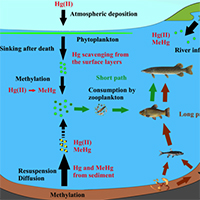Mercury methylation in oxic aquatic macro-environments: a review

Accepted: 27 February 2021
HTML: 106
All claims expressed in this article are solely those of the authors and do not necessarily represent those of their affiliated organizations, or those of the publisher, the editors and the reviewers. Any product that may be evaluated in this article or claim that may be made by its manufacturer is not guaranteed or endorsed by the publisher.
Authors
Mercury methylation in aquatic environments is a key process that incorporates this neurotoxin into the food chain and ultimately the human diet. Mercury methylation is considered to be essentially biotic and mainly driven by sulfate-reducing bacteria present in the bottom sediments in aquatic systems. However, in recent decades, many researchers have shown that this methylation also occurs in oxic layers in conjunction with a high content of particulate organic matter and localized depletion of dissolved oxygen. The goals of this review are to summarize our current understanding of Hg methylation in water columns of both marine and freshwater environments, as well as to highlight knowledge gaps and future research needs. Most of the literature showed that suspended particles (known as marine and lake snow) could be the microenvironment in which Hg methylation could occur across oxic water columns, because they have been recognized as a site of organic matter mineralization and as presenting oxygen gradients around and inside them. To date, the majority of these studies concern marine environments, highlighting the need for more studies in freshwater environments, particularly lacustrine systems. Investigating this new methylmercury production environment is essential for a better understanding of methylmercury incorporation into the trophic chain. In this review, we also propose a model which attempts to highlight the relative importance of a MeHg epilimnetic path over a MeHg benthic-hypolimnetic path, especially in deep lakes. We believe that this model could help to better focus future scientific efforts in limnic environments regarding the MeHg cycle.
Edited by
Diego Fontaneto, CNR-IRSA, Verbania, ItalyHow to Cite

This work is licensed under a Creative Commons Attribution-NonCommercial 4.0 International License.
Similar Articles
- Michael SCHAGERL, Irene DROZDOWSKI, David G. ANGELER, Thomas HEIN, Stefan PREINER, Water age – a major factor controlling phytoplankton community structure in a reconnected dynamic floodplain (Danube, Regelsbrunn, Austria) , Journal of Limnology: Vol. 68 No. 2 (2009)
- Javier Sánchez-Hernández, Fernando Cobo, Ontogenetic shifts in terrestrial reliance of stream-dwelling brown trout , Journal of Limnology: Vol. 75 No. 2 (2016)
- Miguel ALVAREZ COBELAS, Carmen ROJO, David G. ANGELER, Mediterranean limnology: current status, gaps and the future , Journal of Limnology: Vol. 64 No. 1 (2005)
- Fabio BUZZI, Phytoplankton assemblages in two sub-basins of Lake Como , Journal of Limnology: Vol. 61 No. 1 (2002)
- Marina MANCA, Patrizia COMOLI, Studies on zooplankton of Lago Paione Superiore , Journal of Limnology: Vol. 58 No. 2 (1999)
- Giampaolo ROSSETTI, Koen MARTENS, Claude MEISCH, Stefano TAVERNELLI, Valentina PIERI, Small is beautiful: diversity of freshwater ostracods (Crustacea, Ostracoda) in marginal habitats of the province of Parma (Northern Italy) , Journal of Limnology: Vol. 65 No. 2 (2006)
- Walter AMBROSETTI, Luigi BARBANTI, Physical limnology of Italian lakes. 1. Relationship between morphometry and heat content , Journal of Limnology: Vol. 61 No. 2 (2002)
- Hiroshi Kagoshima, Satoshi Imura, Atsushi C. Suzuki, Molecular and morphological analysis of an Antarctic tardigrade, Acutuncus antarcticus , Journal of Limnology: Vol. 72 No. s1 (2013): 12th International Symposium on Tardigrada
- Pietro VOLTA, Niels JEPSEN, The recent invasion of Rutilus rutilus (L.) (Pisces: Cyprinidae) in a large South- Alpine lake: Lago Maggiore , Journal of Limnology: Vol. 67 No. 2 (2008)
- Juan Manuel MEDINA-SÁNCHEZ, Manuel VILLAR-ARGAIZ, Pedro SÁNCHEZ-CASTILLO, Luis CRUZ-PIZARRO, Presentación CARRILLO, Structure changes in a planktonic food web: biotic and abiotic controls , Journal of Limnology: Vol. 58 No. 2 (1999)
<< < 70 71 72 73 74 75 76 77 78 79 > >>
You may also start an advanced similarity search for this article.
-
Juanjo RodríguezFrontiers in Marine Science : 2023
-
Thibaut Cossart, Javier Garcia-Calleja, João P. Santos, Elaheh Lotfi Kalahroodi, Isabelle A. M. Worms, Zoyne Pedrero, David Amouroux, Vera I. Slaveykova, Kevin WilkinsonEnvironmental Chemistry : 2022
-
Eric Capo, Claudia Cosio, Elena Gascón Díez, Jean-Luc Loizeau, Elsa Mendes, Thierry Adatte, Sören Franzenburg, Andrea G. BravoWater Research : 2023
-
Laura Marziali, Roberta Piscia, Lucia Valsecchi, Claudio Roscioli, Marina MancaWater : 2022
-
Laura Balzer, Carluvy Baptista-Salazar, Sofi Jonsson, Harald BiesterBiogeosciences : 2023
-
Diva Scuvée, Marisol Goñi-Urriza, Claire Gassie, Bahia Khalfaoui-Hassani, Rémy GuyoneaudMicrobiological Research : 2023
-
María del Carmen Diéguez, Marina Arcagni, Andrea Rizzo, Soledad Pérez Catán, Carolina Soto Cárdenas, Milena Horvat, Sergio Ribeiro GuevaraNatural and Social Sciences of Patagonia : 2022
-
Vincent Noël, Kristin Boye, Hannah R. Naughton, Emily M. Lacroix, Meret Aeppli, Naresh Kumar, Scott Fendorf, Samuel M. WebbFrontiers in Environmental Chemistry : 2024
-
Daniel González-Reguero, Marina Robas-Mora, Agustín Probanza Lobo, Pedro Antonio Jiménez GómezWorld Journal of Microbiology and Biotechnology : 2023

 https://doi.org/10.4081/jlimnol.2021.2007
https://doi.org/10.4081/jlimnol.2021.2007





